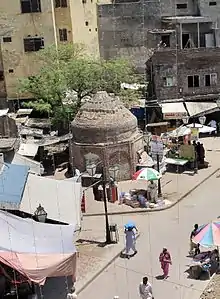Wazir Khan Chowk
The Wazir Khan Chowk (Urdu: وزیر خان چوک) is a town square located in the Walled City of Lahore, Pakistan that is located at the main entrance of the Wazir Khan Mosque.
| Wazir Khan Chowk وزیر خان چوک | |
|---|---|
| Town square | |
| Chowk Wazir Khan, Wazir Khan Square | |
 View of the entryway of the Wazir Khan Mosque from Wazir Khan Chowk | |
| Surface | Brick |
| Location | Walled City of Lahore in front of the Wazir Khan Mosque Lahore, Pakistan |
| Coordinates: 31°34′59″N 74°19′24″W | |
Location
Wazir Khan Chowk is located at the main entrance to the Wazir Khan Mosque, and is located approximately 250 metres west of the Delhi Gate. Access to the town square from Delhi Gate is through the smaller Chitta Gate.
Structures located in the square
Wazir Khan Chowk features the tomb of the Sufi saint Said Soaf, and the Well of Dina Nath.
Restoration

In 2012, the Pilot Urban Conservation and Infrastructure Improvement Project—the Shahi Guzargah Project was launched by the Government of Punjab, and the Aga Khan Trust for Culture (AKTC) which restored a section of Shahi Guzargah which included the Wazir Khan Chowk.[1] Prior to completion of the project's first phase, the square had been encroached upon by illegally erected shops which blocked off much of the mosque from the surrounding neighborhood. The first phase of the project removed illegally constructed shops, restoring views of the mosque. Wazir Khan Chowk was extensively rehabilitated by removal of 73 illegally constructed buildings, while the well of Dina Nath was also restored.[2] Power lines along the project corridor were also placed underground. The Chitta Gate at the eastern entrance to Wazir Khan Chowk was rehabilitated.[3]
In December 2015, further efforts to restore the site were launched by the AKTC with funding from the Ambassadors Fund for Cultural Preservation - a programme run by the United States Department of State.[4] Under the ₨112 (70¢ US) million plan, the town square will be lowered to the original depth found during the Mughal era in order to fully expose the mosque's original façade.[5] Shopkeepers which have occupied hujras, or cells in the mosque designed for religious study, will also be removed, while two historic homes will also be restored.[6] The project will also include further restoration works to the Dina Nath well, and will also include improved outdoor lighting.[7] The project will restore the square to its original appearance, and is expected to require 18 months for completion.[8] The government of the United States of America has provided $1.1 million of the projects costs.[9]
References
- Qureshi, Tania (3 October 2015). "Shahi Guzargah" inside the Walled City of Lahore". Pakistan Today. Retrieved 26 August 2016.
- "Wazir Khan Mosque rehabilitation starts". The News. 22 December 2015. Retrieved 27 August 2016.
- Raza, Ali (24 May 2016). "Conservation of Wazir Khan Masjid begins". The News. Retrieved 26 August 2016.
- "Wazir Khan Mosque rehabilitation starts". The News. 22 December 2015. Retrieved 27 August 2016.
- "Wazir Khan Mosque rehabilitation starts". The News. 22 December 2015. Retrieved 27 August 2016.
- "Wazir Khan Mosque rehabilitation starts". The News. 22 December 2015. Retrieved 27 August 2016.
- "Wazir Khan Mosque rehabilitation starts". The News. 22 December 2015. Retrieved 27 August 2016.
- "Wazir Khan Mosque rehabilitation starts". The News. 22 December 2015. Retrieved 27 August 2016.
- "U.S. Ambassadors Fund for Cultural Preservation Supports Conservation of Lahore's 17th Century Chowk Wazir Khan". US Embassy (Islamabad). 2 October 2015. Retrieved 27 August 2016.